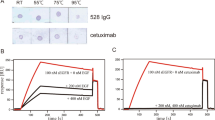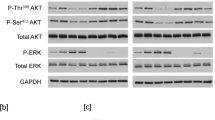Abstract
In the present study we utilized two previously described monoclonal antibodies (mAb), and their respective Fab portions, directed against the extracellular domain of p185HER2, a transmembrane glycoprotein with intrinsic tyrosine kinase activity coded by theHER2/neu oncogene, to study the mechanism of mAb-induced receptor internalization and phosphorylation. Fluorescence scan analysis and direct binding of radiolabelled mAb and their Fab fragments showed that entire MGR2 and MGR3 mAb were reactive with similar binding affinity on two cell lines (Calu-3 and Sk-Br-3) overexpressing the p185HER2 receptor, and unreactive on unrelated cells. The corresponding Fab fragments were positive on the related cells, but bound with diminished intensity and affinity. Entire MGR2 and MGR3 induced internalization in both Calu-3 and Sk-Br-3 cells, whereas their Fab portions were not internalized. When the bivalency of the MGR2 Fab fragment was artificially reconstituted by incubation with rabbit anti-(mouse IgG), internalization was obtained. Monovalent binding of the entire labelled antibodies, obtained in the presence of a saturating amount of unlabelled antibody, decreased both the rate and the final amount of internalized antibody. Metabolic labelling and immunoblotting experiments showed that incubation with entire MGR3 amplified the basal phosphorylation of the p185HER2 receptor in Calu-3 and Sk-Br-3 cells, whereas MGR3 Fab decreased the signal. Taken together, our data indicate that antibody-mediated activation of p185HER2 in Calu-3 and Sk-Br-3 cells occurs through the dimerization of receptor molecules and that bivalency of the activating antibody is mandatory for induction of internalization and phosphorylation of the receptor. Our data support an allosteric model of activation for the p185HER2 receptor.
Similar content being viewed by others
References
Bargmann CI, Hung MC, Weinberg RA (1986) The neu oncogene encodes an epidermal-growth-factor receptor-related protein. Nature 319: 226
Coussens L, Yang-Feng TL, Liao Y-C, Chen E, Gray A, McGrath J, Seeburg PH, Libermann TA, Schlessinger J, Francke U, Levinson A, Ullrich A (1985) Tyrosine kinase receptor with extensive homology to EGF receptor shares chromosomal location with neu oncogene. Science 230: 1132
Gill GN, Kawamoto T, Cochet C, Le A, Sato JD, Masui H, Mcleod C, Mendelsohn J (1984) Monoclonal anti-epidermal growth factor receptor antibodies which are inhibitors of epidermal growth factor binding and antagonists of epidermal growth factor-stimulated tyrosyne protein kinase activity. J Biol Chem 259: 7755
Lupu R, Colomer R, Zugmaier G, Sarup J, Shepard M, Slamon D, Lippman ME (1990) Direct interaction of a ligand for the erbB2 oncogene product with the EGF receptor and p185 erbB2. Science 249: 1552
Maier LA, Xu FJ, Hester S, Boyer CM, McKenzie S, Bruskin AM, Argon Y, Bast RC (1991) Requirements for the internalization of a murine monoclonal antibody directed against the HER-2/neu gene product c-erbB-2. Cancer Res 51: 5361
Ménard S, Canevari S, Casalini P, Da Dalt MG, Mezzanzanica D, Colnaghi MI (1989) Scatchard plot analysis for the evaluation of the monoclonal antibody affinity constant for cellular antigens: a “constant” which varies with the epitope density. J Immunol Res 1: 155
Peles E, Bacus SS, Koski RA, Lu HS, Wen D, Ogden SG, Ben Levy R, Yarden Y (1992) Isolation of the neu/HER-2 stimulatory ligand: A 44 kd glycoprotein that induces differentiation of mammary tumor cells. Cell 69: 205
Perez P, Hoffman RW, Titus JA, Segal DS (1986) Specific targeting of human peripheral blood T cells by heteroaggregates containing anti-T3 cross linked to anti-target antibodies. J Exp Med 163: 166
Roosnek E, Lanzavecchia A (1989) Triggering T cells by otherwise inert hybrid anti-CD3/antitumor antibodies requires encounter with the specific target cell. J Exp Med 170: 297
Sato GH, Sato JD (1989) Growth factor receptor monoclonal antibodies and cancer immunotherapy. JNCI 81: 1600
Schreiber AB, Lax I, Yarden Y, Eshhar Z, Schlessinger J (1981) Monoclonal antibodies against receptor for epidermal growth factor induce early and delayed effects of epidermal growth factor. Proc Natl Acad Sci USA 78: 7535
Schreiber AB, Libermann TA, Lax I, Yarden Y, Schlessinger J (1982) Biological role of epidermal growth factor-receptor clustering investigation with monoclonal anti-receptor antibodies. J Biol Chem 258: 846
Spaargaren M, Defize LHK, Delaat SW, Boonstra J (1990) Antibody-induced activation of the epidermal growth factor receptor tyrosine kinase requires the presence of detergent. Biochem Biophys Res Commun 171: 882
Spaargaren M, Defize LHK, Boonstra J, De Laat SW (1991) Antibody-induced dimerization activates the epidermal growth factor receptor tyrosine kinase. J Biol Chem 266: 1733
Stern DF, Kamps MP (1988) EGF-stimulated tyrosine phosphorylation of p185: a potential model for receptor interactions. EMBO J 7: 995
Sunada H, Magun BE, Mendelsohn J, Macleod CL (1986) Monoclonal antibody against epidermal growth factor receptor is internalized without stimulating receptor phosphorylation. Proc Natl Acad Sci USA 83: 3825
Tagliabue E, Centis F, Campiglio M, Mastroianni A, Martignone S, Pellegrini R, Casalini P, Lanzi C, Ménard S, Colnaghi MI (1991) Selection of monoclonal antibodies which induce internalization and phosphorylation of p185HER2 and growth inhibition of cells with HER2/neu gene amplification. Int J Cancer 47: 933
Tarakhovsky A, Zaichuk T, Prassolov V, Butenko ZA (1991) A 25 kDa polypeptide is the ligand for p185neu and is secreted by activated macrophages. Oncogene 6: 2187
Yamamoto T, Ikawa S, Akiyama I, Semba K, Momura M, Miyasima N, Saito T, Toyoshima K (1986) Similarity of protein encoded by the human c erb B-2 gene to epidermal growth factor receptor. Nature 319: 230
Yarden Y (1990) Receptor-like oncogenes: functional analysis through novel experimental approaches. Mol Immunol 27: 1319
Yarden Y (1990) Antagonistic antibodies stimulate the kinase encoded by the neu protooncogene in living cells but the oncogenic mutant is costitutively active. Proc Natl Acad Sci USA 87: 2569
Yarden Y, Peles E (1991) Biochemical analysis of the ligand for theneu oncogenic receptor. Biochemistry 30: 3543
Yarden Y, Schlessinger J (1987) Epidermal growth factor induces rapid, reversible aggregation of the purified epidermal growth factor receptor. Biochemistry 26: 1443
Yarden Y, Schlessinger J (1987) Self-phosphorylation of epidermal growth factor receptor: evidence for a model of intermolecular allosteric activation. Biochemistry 26: 1434
Author information
Authors and Affiliations
Rights and permissions
About this article
Cite this article
Srinivas, U., Tagliabue, E., Campiglio, M. et al. Antibody-induced activation of p185HER2 in the human lung adenocarcinoma cell line Calu-3 requires bivalency. Cancer Immunol Immunother 36, 397–402 (1993). https://doi.org/10.1007/BF01742256
Received:
Accepted:
Issue Date:
DOI: https://doi.org/10.1007/BF01742256




